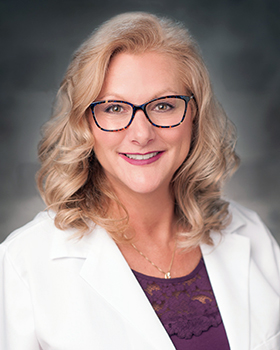
A York University assistant professor of nursing merges her knowledge of nursing with directing the development of video simulation games to provide students with the critical practical skills they were not able to get in person during the pandemic.
By Elaine Smith

Lights, camera, nursing assessment? It’s a sequence that makes perfect sense to Brenda Orazietti, an assistant professor of nursing (teaching stream) at York University.
During the pandemic, Orazietti wrote and directed five video clinical nursing simulation games (VSGs) that provide nursing students with the practical experience they weren’t able to get in person due to cancelled placements and practicums. The videos were funded by a York Academic Innovation Fund (AIF) grant and a Virtu-WIL grant from Colleges & Institutes Canada. Her nursing peers collaborated with Orazietti in the writing of the games, filming and acting.
VSGs are immersive computerized games that allow students to learn how to care for patients with complex illnesses in a way that is similar to the experience they would have in an actual clinical setting. Orazietti wanted to create resources that offered clinical learning opportunities to students at no cost to the faculty members and students. Students go through these simulations asynchronously at their own pace and have a synchronous debriefing afterward with a professor.
“Students can repeat the simulations over and over and reinforce the lessons they need,” says Orazietti. “The focus is on clinical decision-making and clinical judgment, so the students understand what they are doing and why and to prevent complications. The VSGs support safe practices that can be translated into the real environment.
“These VSGs are robust and detailed and can be used online at home, in a lecture hall or even in a simulation lab. They could be part of a course or assigned as homework,” says Orazietti. “The structure of the VSGs also aligns with clinical decision-making models that further supports the format of the licencing exam (NCLEX).”
Creating the VSGs was more challenging than Orazietti first imagined due to pandemic restrictions and it became her sabbatical project. She turned her basement into a movie set, and purchased, borrowed or created props to make the scenarios come alive. When she discovered, for example, that an IV pump cost $5,000, Orazietti fashioned a simulated pump out of a tissue box and “it was realistic enough – as it looked fine in the video.”
She also recruited friends, colleagues and neighbours to serve as actors and as stagehands; it took a minimum of six people to film each VSG. Orazietti wrote the lines for each actor on flip charts in large print so the volunteers could read their lines. The scripts involved pathophysiology, physical assessments, medications and interventions that were complex; some scripts were 40 pages long.

“We are not professional actors, so trying to ease that tension was important so that the scenes appeared more natural,” says Orazietti, noting that it was also very helpful to have an assistant from ADS Media who was hired for editing and to assemble the games.
“Even with the drive to initiate and create these VSGs, you need money, people and time. Without a sabbatical and the grants, it wouldn’t have been possible,” she says.
Her VSGs have varied and valuable scenarios:
- post-partum assessment of a new mother;
- addressing end-stage liver failure;
- dealing with liver transplant donors;
- working with a newly diagnosed patient with prostate cancer; and
- addressing the dangers of marijuana edibles.
Each video starts with a case summary and learning objectives and readings that the student must do in preparation for the simulation, which follows. Each scenario is quite detailed – a family member may have questions, for example – and there are online questions throughout that require the student to click on the right answer. Rationales are presented for each question asked to support their learning.
“I have been involved in simulations in the lab since I began teaching nursing more than 20 years ago,” Orazietti says, “but virtual resources are newer and once the pandemic came along, we needed a quick pivot to compensate for cancelled practicums. I had to learn to create the videos and how to lead teams for each game. I see this method of learning as the way of the future and replacing many of the expensive mannequins we have used for years. Virtual reality is also a new and budding method where a headset is worn to immerse the student in a clinical situation.”
The VSGs are available to nursing faculty across Canada free of charge if they are members of Can-Sim. Orazietti gave a presentation about her process during a recent Teaching for Transformation conference at the University of Toronto and presented the project itself to York’s AIF group. She also hosted a faculty development presentation for her colleagues to discuss best practices for using simulations in teaching.
“I am very proud and happy that this project has been completed,” says Orazietti. “I’m sure these VSGs will help nursing students across the country learn; in fact, nurses at any level can benefit from them.”
She enjoyed the experience, noting, “My husband now calls me Scorcese.”
